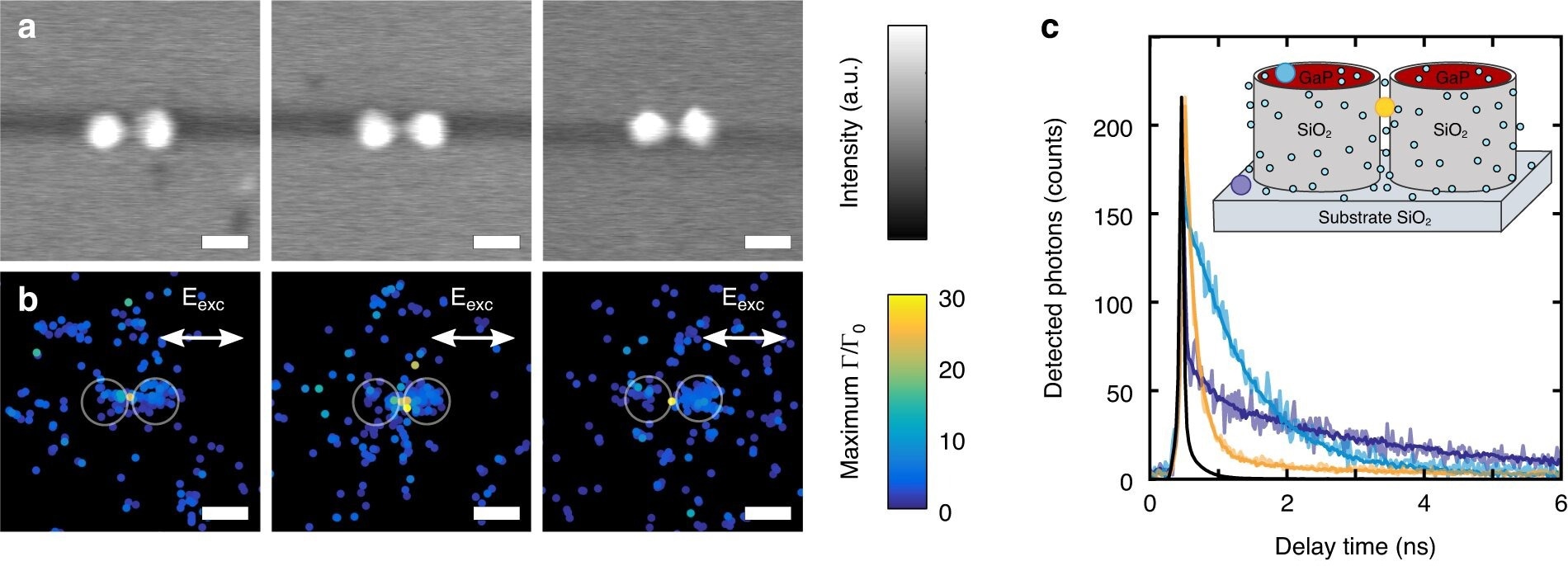A study published in Light: Science & Applications demonstrates a significant advancement in an era where understanding and controlling light at the nanoscale is becoming increasingly important.
 smFLIM image of the decay rate enhancement induced by GaP dimers. Image Credit: Light: Science & Applications (2024). DOI: 10.1038/s41377-023-01349-2
smFLIM image of the decay rate enhancement induced by GaP dimers. Image Credit: Light: Science & Applications (2024). DOI: 10.1038/s41377-023-01349-2
Using single molecules as probes, a group of researchers from the Institut Langevin, ESPCI Paris, PSL University, and CNRS has created an advanced technique to quantify the amplification of light interaction at the nanoscale. Dielectric gap nanoantennas, created and produced at Imperial College London, are essential to this study.
Gallium phosphide (GaP), selected for these structures due to its high refractive index and minimal optical losses, is used to make them. Through single molecules and a novel approach that modifies the nanosystem with near-field probes without altering the enhanced light interaction facilitated by these nanoantennas, this collaborative work achieves a notable 30-fold enhancement in radiative decay rates at the single-molecule level.
The researchers added, “Our work focuses on the precise measurement of how light interacts with nanostructures. By using single molecules as probes, we have been able to observe and quantify the enhancement in light interaction, a crucial aspect for advancing nanophotonic technologies.”
Beyond theoretical investigation, the research provides useful insights into the interplay between light and matter.
“This is not just about observing enhanced light interaction; it's about measuring it at the single-molecule level with remarkable spatial precision. Our findings are pivotal for future applications in fields where understanding and controlling light at such a small scale are essential,” the researchers further added.
The findings and methodology of the study highlight the value of sophisticated measurement methods in nanophotonics.
The researchers further stated, “Our research has successfully mapped the spatial distribution of radiative decay rate enhancement, revealing that while there is some mislocalization of single molecules due to their interaction with the structure, this effect is minimal within the gap of the nanoantenna, providing a precise control of bright single-photon emission source.”
“This precision in measurement opens up new avenues for the characterization of highly sensitive optical devices and deepens our understanding of the interaction enhancement of a quantum emitter with a nanostructure.”
The scientists stress the wider ramifications of their discovery in their conclusion.
“Our research provides a new lens through which to view nanophotonic interactions. The ability to measure light interaction with such precision paves the way for breakthroughs in various applications, from quantum computing, quantum sensing to medical diagnostics.”
Journal Reference:
Córdova-Castro, R. M., et. al. (2023) Single-emitter super-resolved imaging of radiative decay rate enhancement in dielectric gap nanoantennas. Light: Science & Applications. doi:10.1038/s41377-023-01349-2.